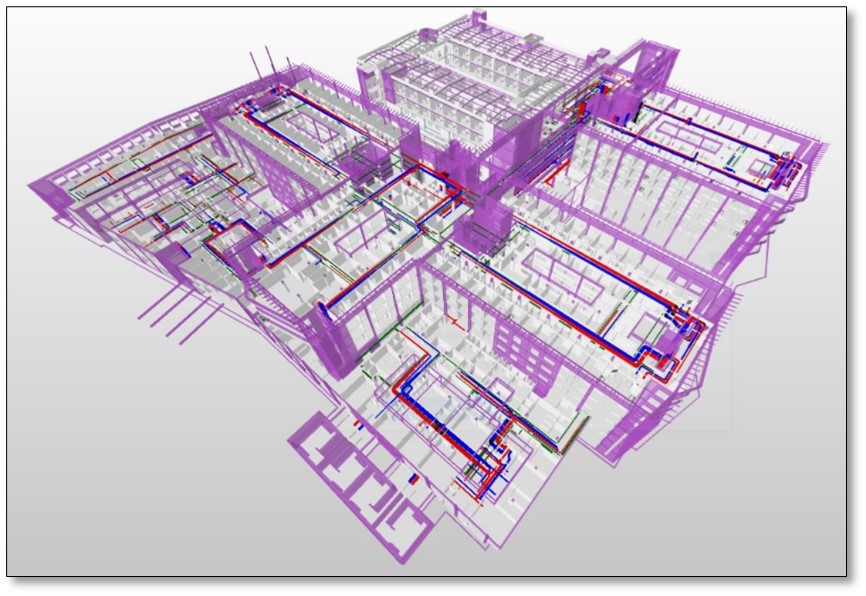AUTHOR: Federica Capone
TUTORS: Alessandro Zichi
INTERNSHIP: Impresa Percassi s.p.a.
MASTER: Master in “BIM MANAGER” a.a 2020/21
Obiettivo del presente lavoro è analizzare i vantaggi della progettazione dei sistemi ospedalieri in BIM, attraverso l’analisi dello sviluppo progettuale (dalla fase definitiva a quella realizzativa) della Cittadella della salute di Treviso, commessa per la quale ho svolto il ruolo di assistente al coordinamento interdisciplinare inizialmente e BIM Coordinator poi.
Il progetto esecutivo della Macroarea Ospedaliera dell’Ospedale di Treviso è primo classificato nell’ambito dei grandi interventi pubblici al BIM&DIGITAL AWARD 2019.
Progettare ospedali, in particolare nella contingenza attuale, richiede infatti un approfondito quadro conoscitivo delle discipline specialistiche finalizzato a rispondere a specifiche richieste variabili in relazione ai bacini di utenza e ai requisiti espressi dalle amministrazioni pubbliche. La progettazione sanitaria deve tener conto delle esigenze legate al comfort e alla sanificazione, ma anche alle funzionalità richieste dalle diverse aree e zone di cui una struttura ospedaliera è composta sia ottimizzando i costi in fase costruttiva ma anche garantendo funzionalità per tutta la vita utile dell’edificio.
Nell’ambito di un’architettura complessa, quale quella ospedaliera, il tema della manutenzione è nevralgico per il funzionamento degli asset e per l’operatività interna (comfort, sicurezza e salute). La qualità del servizio reso all’utenza, infatti, è garantita solo se il tema della manutenzione viene affrontato direttamente in sede progettuale, come stabilito dagli obblighi di legge.
Progettare ospedali in BIM significa dunque mettere a disposizione del servizio sanitario una serie di big data sviluppati ed analizzati in fase progettuale che, implementati, permettano l’efficienza e l’efficacia del sistema ospedale stesso.
Il vantaggio competitivo dell’applicazione del BIM si concretizza solo se vengono definite accuratamente la metodologia di lavoro, la contemporaneità dello sviluppo dei modelli nelle diverse discipline, l’applicazione dei protocolli di interoperabilità, la definizione dei ruoli di coordinamento per la verifica delle diverse discipline. Applicare la metodologia BIM in modo corretto consente maggiore qualità del progetto, riduzione degli errori progettuali, riduzione dei costi di cantiere, perfetta gestione degli spazi, controllo e riduzione dei costi in qualsiasi fase della progettazione.
In prospettiva il BIM favorisce migliore gestione dell’opera durante il suo ciclo di vita (Facility management) e mantenimento della qualità dell’opera nel caso di successivi interventi.
FOR INTERNATIONAL STUDENTS:
The aim of this work is to analyze the advantages of the design of hospital systems in BIM, through the analysis of the design development (from the design phase to the realization phase) of the Cittadella della salute of Treviso, a contract for which I played the role of assistant to the interdisciplinary coordination initially and BIM Coordinator then.
The executive project of the Hospital Macroarea of the Treviso Hospital is first classified in the context of major public interventions at the BIM & DIGITAL AWARD 2019.
Designing hospitals, especially in the current contingency, requires an in-depth cognitive framework of the specialized disciplines aimed at responding to specific variable requests in relation to the catchment areas and the requirements expressed by public administrations. The sanitary design must take into account the needs related to comfort and sanitization, but also to the functionality required by the different areas and areas of which a hospital structure is composed both optimizing costs in the construction phase but also ensuring functionality throughout the useful life of the building.
In the context of a complex architecture, such as the hospital one, the theme of maintenance is crucial for the operation of the assets and for the internal operation (comfort, safety and health). The quality of the service rendered to users, in fact, is guaranteed only if the issue of maintenance is addressed directly during the project, as established by legal obligations.
Designing hospitals in BIM therefore means making available to the health service a series of big data developed and analyzed in the design phase that, implemented, allow the efficiency and effectiveness of the hospital system itself.
The competitive advantage of the application of BIM is realized only if the working methodology is accurately defined, the simultaneous development of models in the different disciplines, the application of interoperability protocols, the definition of coordination roles for the verification of the different disciplines.
Applying the BIM methodology correctly allows higher project quality, reduction of design errors, reduction of construction costs, perfect management of spaces, control and reduction of costs at any stage of the design.
Looking ahead, BIM favors better management of the work during its life cycle (Facility management) and maintaining the quality of the work in the case of subsequent interventions.

